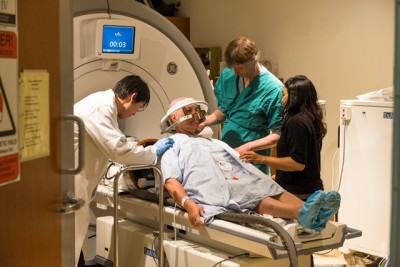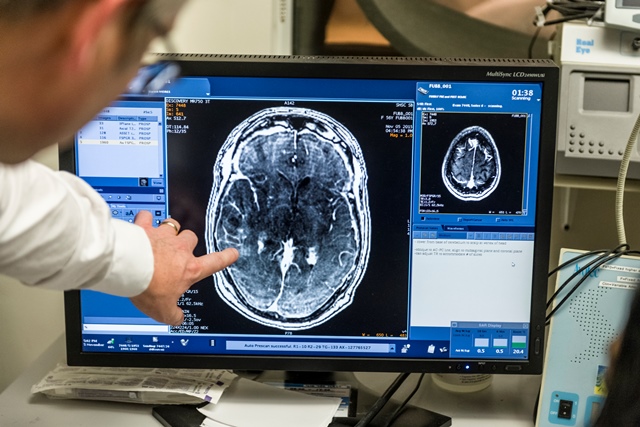For eight years, Bonny Hall managed her brain tumour with medication. But earlier this year, she was given difficult news.
“[My tumour] was starting to grow and I would have to see somebody…like Dr. Mainprize,” said Bonny.
Dr. Todd Mainprize is a neurosurgeon at Sunnybrook. He is also the lead investigator in a groundbreaking clinical trial: for the first time in the world, this Sunnybrook team penetrated the blood-brain barrier non-invasively in a human – in Bonny.
The blood-brain barrier is described as a plastic wrap-like coating around the small blood vessels in the brain that normally restricts the passage of substances from the bloodstream into the brain, protecting it from toxic chemicals.
Unlike other areas of the body, this plastic wrap doesn’t allow most medications to get through, which has implications for many conditions, including brain cancer, Parkinson’s and Alzheimer’s disease.
“Some of the most exciting and novel therapeutics for the treatment of malignant brain tumours are not able to reach the tumour cells because of the blood brain barrier,” says Dr. Mainprize, also an assistant professor in the Division of Neurosurgery at University of Toronto. “Our technique is to essentially tear holes in the plastic wrap and allow the various chemicals we want delivered to the brain, to get into the brain.”

Bonny was given chemotherapy and then later, an injection of microbubbles, or microscopic bits of air. Both circulate in her bloodstream. She was fitted with a specialized helmet-like device – co-developed based on Sunnybrook research – and placed inside an MRI, which helped guide low-intensity ultrasound waves (or sonications) to precise areas in her brain. This causes the microbubbles to shake and temporarily rip holes in the blood-brain barrier, allowing medication to seep into the tumour.
“The trial has gone exactly the way we hoped,” says Dr. Mainprize. During the procedure, nine dots on the brain scan lit up, indicating the opening of the blood-brain barrier. “We are encouraged that we were able to temporarily open this barrier in a patient to deliver chemotherapy directly to the brain tumour. This technique will open up new opportunities to deliver potentially much more effective treatments to the targeted areas.”
Dr. Kullervo Hynynen, Director of Physical Sciences at Sunnybrook Research Institute, worked with industry partner Insightec for almost two decades to develop the technology and bring it to a clinic-ready state. “The success of this case is gratifying,” he says. “My hope now is that many patients will eventually benefit from it.”
Bonny had part of the tumour and surrounding tissues removed in surgery the next day. It was sent to pathology for analysis to determine just how much medication got through.
Since the injected chemotherapy is taken out with the removal of the brain tumour, Bonny and the other research participants in this trial will not benefit from this particular focused ultrasound procedure.
“Research participants, like Bonny, are committing a truly selfless act to help research along so it may be able to help other patients in the future,” says Dr. Mainprize. “Thanks to Bonny and all other participants, this breakthrough opens up potential for delivering drug therapies to parts of the brain that were previously impenetrable because of the blood-brain barrier.”
Bonny said she was both nervous and excited to be the first.
“If I can help in any way, it’s going to be able to look after things like epilepsy, Alzheimer’s and a lot of other diseases. This isn’t just about a brain tumour.”
“We are very lucky at Sunnybrook to have a large interdisciplinary group of physicists, radiologists, neurosurgeons and oncologists that can work together and push this trial forward. We’re very honoured to be the first centre that’s able to do this,” says Dr. Mainprize.
The trial will include six to ten more patients over the coming months – all to make sure opening the blood-brain barrier is safe to penetrate in humans. These research participants are those who are already scheduled for traditional neurosurgery to remove parts of their brain tumour. Enrolment is currently limited to Canadian residents only, due to being an inpatient surgical procedure.
For more information on this research procedure, visit Sunnybrook.ca
And for more information on Insightec, visit insightec.com


